The state lets polluters plant trees to keep river water temps cool. No one knows if the trade-offs actually work
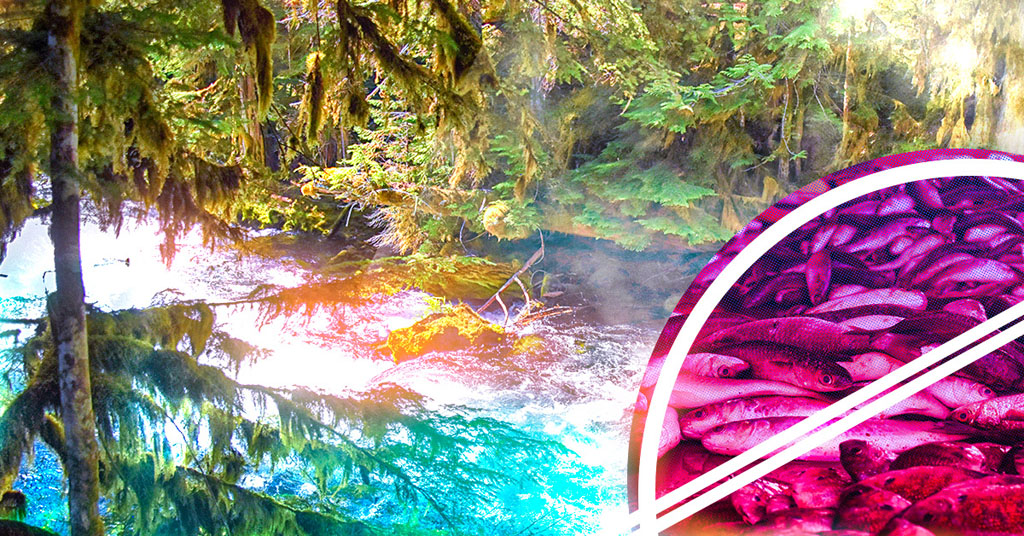
Go with the flow? River water is getting too warm for some fish. “Thermal trading” has emerged as a debatable response. Photo illustration: Nicole Wilkinson
By Kendra Chamberlain. February 29, 2024. In 2012, President Barack Obama praised a deal the City of Medford had made with the state to pay for shade trees to be planted along the Rogue River in order to offset the impacts of warm water discharges from the city’s wastewater treatment plant.
“It worked for business, it worked for farmers and it worked for salmon,” Obama said in a speech at the Department of Interior, adding that the plan represents “the kinds of ideas we need in this country.”
To Nina Bell, executive director of Northwest Environmental Advocates (NWEA), the project was a perfect example of all that’s wrong with Oregon’s thermal trading program.
“You can plant all the trees you want on the main stem of the Rogue River and it’s not going to result in any cooling of water. It just isn’t,” Bell tells Columbia Insight. “The trees do not cast shade across the Rogue River in a way that could ever cause any reduction in temperature.”
Bell is one of the program’s biggest critics, but she’s not alone.
WaterWatch of Oregon, a nonprofit advocacy firm that focuses on water quantity, is currently suing Oregon’s Department of Environmental Quality over its approval of another thermal trading plan.
The group argues that the plan is based on flawed modeling and is too vague for DEQ—or the public—to determine whether it would have the intended impact of cooling water temperatures.
In fact, DEQ, which administers water quality trading programs in the state, doesn’t know if any of the thermal trading plans it approves actually work.
What is thermal trading?
Cold water is becoming increasingly hard to find for many Pacific Northwest fish species that have evolved to depend on them, salmon and steelhead included.
Human-driven ecosystem changes like clear-cut logging along mountain streams, municipal, agricultural and industrial discharges, and water withdrawals, have warmed surface waters to dangerously high levels for cold-water aquatic species.
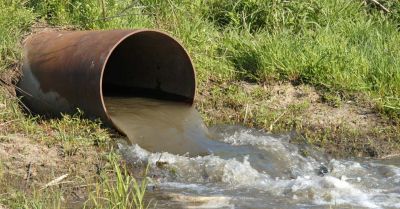
Pipe dream? Some wastewater isn’t just dirty. It’s warm. Photo: Wikipedia
So much so that water temperature fluctuations are treated as a pollutant by state regulators and water temperature is considered a component of water quality.
“In Oregon, we have a unique program in that the pollutant that we are trading for almost exclusively is heat pollution,” says Brian Creutzburg, alternative compliance specialist and basin coordinator at DEQ. “Our streams are too warm and we have set standards for temperature in those streams.”
The state’s thermal trading program attempts to tackle the issue by exchanging pollution permits for projects that promise to cool waters in some areas to offset warmer waters in other areas.
In essence, thermal trading is a mitigation program that allows polluters to continue their damaging activities in exchange for a promise to balance the environmental ledger elsewhere.
These projects often involve riparian restoration and streamside tree planting to help keep waters cool.
Or at least, that’s the idea.
“At best, it’s good in theory. It’s certainly not good in practice, for the most part,” says Bell. “The way they run the program, for the most part, it does not actually have that result [of cooling water] at all.”
Temperature benefits too small to measure
DEQ’s Creutzburg describes the state’s thermal trading program as an “applicant-driven” process.
This means the applicant determines how much temperature needs to be offset, what type of riparian restoration it will pursue to meet that offset and even how the temperature credits will be calculated.
“The water quality trading [program] is a voluntary program. The DEQ sets the parameters of the permits, but we don’t have the authority to tell people how to meet the targets,” says Creutzburg.
Applicants don’t provide DEQ with detailed descriptions of what will be planted, when it will be planted or even where it will be planted—that information is provided to the department in annual reports after approval.

Cool it: Improving fish habitat is a big part of thermal trading programs. Photo Illustration: Nicole Wilkinson
Instead, DEQ evaluates thermal trading plans for compliance with the state’s water quality trading rules.
“Those rules are pretty straightforward, it goes step by step through the different elements that a plan will need to incorporate,” he says.
Creutzburg says the department conducts in-person visits to verify that specific planting projects are being completed as described in the annual reports.
But DEQ doesn’t measure water temperatures at the sites to determine if any cooling is actually occurring.
In fact, says Creutzburg, DEQ isn’t able to tell if the projects are cooling water at all.
“The benefits from [an] individual thermal trading project will be in the hundredths of a degree,” he says. “That’s essentially way outside the realm of our ability to measure that way. So the way we evaluate efficacy is through modeling.”
DEQ developed a model, called the Shade-a-lator, that uses site-specific information including stream size, canopy density and riparian vegetation to help determine how much sunlight would be blocked through restoration projects.
Applicants run their own modeling to determine the temperature impacts of their permit projects and how much riparian restoration is needed to offset those impacts.
DEQ evaluates applicant models to ensure the modeling used is mainstream and scientifically defensible.
“We do check their work. We have two modelers on staff that I will consult with on an as-needed basis,” he says.
Creutzburg says there’s anecdotal evidence that the streamside planting is working, pointing to areas of riparian restoration that fish seem to be treating as cold water refugia.
“The people who do this work, they see the streams on a regular basis and it’s hard not to notice the fish,” he said. “It is a real effect, scientifically. Unfortunately, we don’t have the perfect information we would like to have on stream temperature at individual streams.”
Planting for ‘ecological uplift’
Clean Water Services is a wastewater management utility in Washington County, Oregon, on Portland’s west side.
The company has engaged in thermal trading projects since 2004. It developed its own in-house riparian enhancement program that handles tree-planting projects along the Tualatin River and its tributaries, rather than relying on environmental consultants.
“We are somewhat different. We do the work ourselves,” Bob Baumgartner, regulatory affairs director at Clean Water Services, tells Columbia Insight.
The company collaborates with the Tualatin Soil and Water Conservation District, private agricultural land owners and public agencies that own park lands for opportunities to engage in riparian restoration projects, which it can then use to generate credits that go toward offsetting thermal impacts of its operations.
Baumgartner says the restoration projects are selected for the broad ecological benefits they will produce, not just shading water to keep it cool.
“A lot of that has to do with creating ecological uplift—ecosystem services is what they call it—where we can get multiple benefits from the shading,” he says. “We look for opportunities for habitat improvement, to improve overall ecological function.”
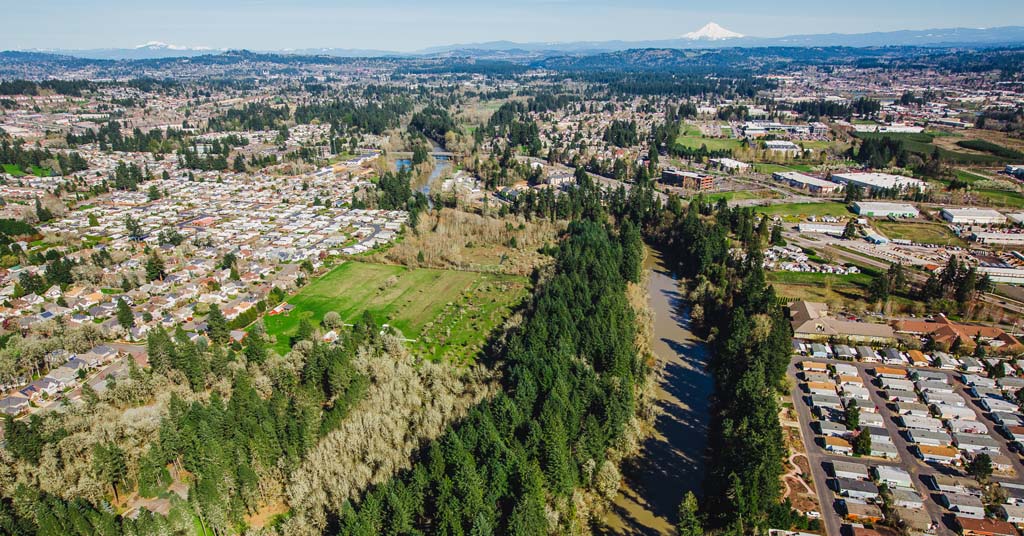
Under pressure: In Oregon’s Washington County, water from the Tualatin River is in high demand for agricultural, industrial and urban use. Trees and vegetation cast shadows across the water. Photo: Clean Water Services
Baumgartner says the company also works with entities like the Tualatin River Watershed Council to identify where riparian restoration projects can target protecting or expanding cold water refugia for fish.
Clean Water Services may be considered a poster child for Oregon’s thermal trading program. Attorney Nina Bell points to the company as an example of how riparian restoration can work when it’s well executed.
But even Clean Water Services can’t tell how—or if—its shade projects are directly impacting water temperatures in the restoration areas.
“Stream temperatures are naturally variable, changing throughout the day and from one day to the next depending on weather and location,” says Jamie Hughes, program manager at Clean Water Services’ regulatory affairs department. “It is often difficult to separate out the benefit of the shading from all the other factors influencing temperature.”
Hughes adds that in some project areas, there’s reason to believe their shade planting is helping keep water cooler downstream.
And as long as the project delivers the shade it’s designed to deliver, it’s consistent with DEQ’s thermal trading rules.
Pros and cons
After testing in the early 2000s, Oregon’s thermal trading program was codified in state law in 2015.
Subsequent reviews have been mixed.
One view of thermal trading is that despite its intended public benefits, programs inevitably devolve into market-driven mechanisms.
In this condition, accountability dwindles and thermal trading programs are seen simply as a way to allow polluters to avoid the expense of constructing cooling towers and storage lagoons or implementing other mitigation strategies before discharging heated water into rivers and streams. [A previous version of this story incorretly stated that wastewater utilities heat water during the treatment phase. According to Oregon DEQ: “The heat pollution discussed in the article comes from all of us, e.g., everyone who showers with hot water, uses hot water to wash dishes, etc. In other words, the heated water comes from water heaters in people’s homes.” —Editor]
Natural disasters, such as the wildfires that tore through the Willamette Valley in 2021, can and do wipe out riparian buffers.
Importantly, riparian canopies don’t actually cool water; they only prevent it from warming.
For various reasons, the state of Washington has declined to follow Oregon’s lead, though it has considered thermal trading programs.
“While thermal trading is certainly something that comes up to try to address temperature pollution, there haven’t been any proposals to us over the past decade to start a thermal trading program,” Washington Department of Ecology Water Quality Communications Manager Colleen Keltz told Columbia Insight in an email. “Ecology considers the most logical pollutants for trading are phosphorus, nitrogen other oxygen-related pollutants and sediment. We will consider trades involving temperature, although the lengthy time lag to produce shade may prohibit temperature trades in many watersheds.”
[perfectpullquote align=”full” bordertop=”false” cite=”” link=”” color=”” class=”” size=””]Absent important details, the public can’t truly weigh in on the efficacy of thermal trading plans.[/perfectpullquote]
Proponents of thermal trading (occasionally referred to as “shade trading”) point out that traditional methods of decreasing the temperature of treated wastewater with cooling towers and storage tanks require enormous amounts of energy, concrete structures and other environmentally disruptive activities.
Erecting massive infrastructure, in effect, amounts to a mechanical fix for a natural problem.
Wastewater has to go somewhere, all disposal systems are imperfect and temperature is just one facet of water quality.
Because temperature is easy to measure, track and regulate, a system has been built around it.
Yet a diverse riparian habitat delivers far more than just temperature benefits.
In focusing on the shortcomings of thermal trading programs, supporters say critics are blinding themselves to the broader good—that “ecological uplift”—they provide.
Watching the bottom line
In Oregon, The Freshwater Trust has emerged as a leader in implementing thermal trading programs for utilities and other large polluters, earning $5.3 million and $4.7 million through its water quality trading services in 2020 and 2021, respectively, according to its IRS filings.
The Portland-based nonprofit has contracted with the City of Medford, City of Ashland, Metropolitan Wastewater Management Commission of Eugene-Springfield, Portland General Electric, Idaho Power Company and others with a goal to, in at least one case, “promote implementation of agricultural best practices that enhance freshwater ecosystems and improve farmers’ bottom lines.”
According to a post on The Freshwater Trust’s website, “Chillers and storage lagoons can cost millions of dollars just to build, whereas natural infrastructure alternatives are often the lowest cost alternative over time.”
In 2021, it estimated the City of Medford would have had to spend “upwards of $20 million” in 2011 to invest in a cooling tower or chiller. Instead, “the city partnered with TFT to the tune of $6.5 million.”
But the question remains, to what degree did those thermal trading programs decrease water temperatures?
The Freshwater Trust declined several requests over a period of weeks to comment on this story or explain how it measures the success of its programs.
Mischief in modeling
WaterWatch’s lawsuit is over a thermal trading plan DEQ approved in 2018 for the Willamette Water Supply System (WWSS) in connection to its proposal to withdraw up to 150 million gallons of water per day from the Willamette River over the next 60 years.
The Willamette River already fails to meet state water quality standards because the water in the river reaches temperatures deemed by the state to be too hot for cold-water species.
DEQ acknowledged that WWSS’s water withdrawal proposal would further raise the temperature of water in the Willamette and asked WWSS to address those temperature impacts.
WaterWatch alleges WWSS and the consultancy firm it hired dramatically underestimated the temperature impacts its proposal would have on the river in its modeling assumptions in order to reach a more palatable thermal trading plan.
“The assumptions that we think the model should have included, what was the most reflective of their actual impact, would have required [WWSS] to do about 40 miles of streamside shading or of riparian restoration. They cut that number down to three miles of shading,” WaterWatch staff attorney Brian Posewitz tells Columbia Insight. “It’s a really graphic illustration of how much they reduced their obligation and then DEQ just went along with that.”
WaterWatch also contends that the thermal trading plan that WWSS submitted based on its modeling was too vague to be effectively evaluated.
Posewitz argues thermal trading plans approved by DEQ “just sort of described general approaches that might work to offset the impact as opposed to, ‘here’s the project we’re going to do, and here’s how much offset we’re going to create.’
“Our position is that when you approve these plans, you’re supposed to be making a determination that the plan is going to offset the impact that the applicant is having,” he says. “If the plan is inadequate, they are violating water quality laws.”
As it stands, Posewitz doesn’t believe DEQ can know whether or not WWSS’s thermal trading plan will result in the intended temperature offsets, because the department doesn’t require enough information to make that determination.
And without those important details, the public can’t truly weigh in on the thermal trading plan, either.
“There’s a lot of potential for thermal trading to be manipulated and misused in a way such that the temperature impact needing to be offset really isn’t offset,” says Posewitz. “There’s a lot of devil in the details.”


 Columbia Insight’s reporting on biodiversity in Oregon is supported by the Autzen Foundation.
Columbia Insight’s reporting on biodiversity in Oregon is supported by the Autzen Foundation. 

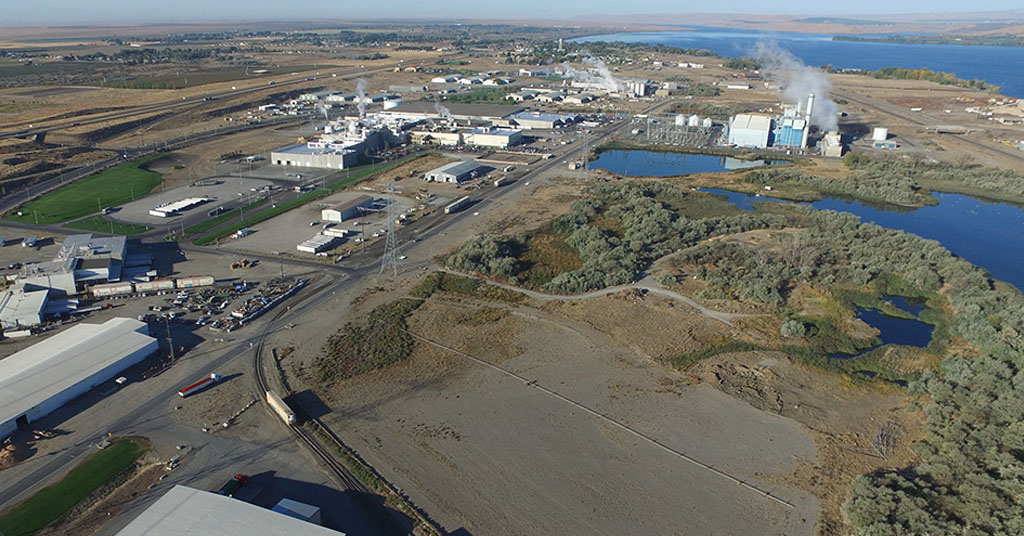
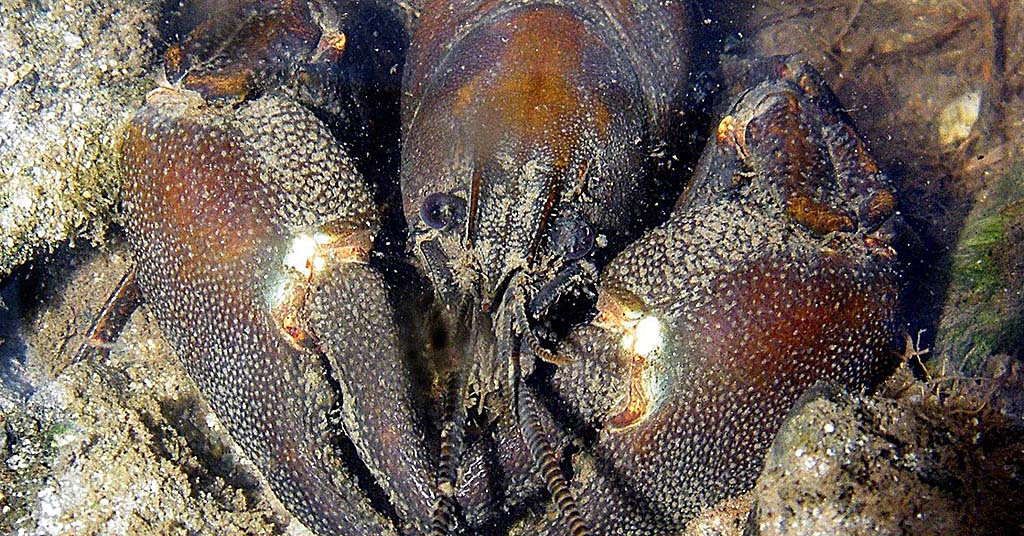




Interesting article, and an important topic as we wrestle with protecting water quality for humans and fish, while simultaneously trying to mitigate climate change causing greenhouse gases. However, I believe you downplayed the expense and carbon emissions related to actively cooling water. The title and some of the text implies that stream shading and other natural approaches to cooling water are more expensive than the traditional, active cooling alternative, when so far at lest they are a modest fraction of the cost. Shade is not the only benefit of riparian/floodplain restoration. Increasing hyporheic flow and floodplain connectivity does actually cool (and clean) water by passing it through the ground. Finally many of the issues raised have less to do with the approach than the regulation of the approach. The WWSP got a sweet deal, but that does not mean the approach itself is invalid. Clearly we should keep working on the models and the science to make sure the ecosystem gets a fair deal, but trying things at scale is the only way to figure out if they are viable.
I was certainly disappointed with some of the characterizations in this article. Characterizing wastewater utilities as ‘polluters’ or ‘companies’ out to make a buck at the expense of the environment is just not an accurate depiction. The easiest thing for utilities to do to address temperature would be to build a chiller or cooling tower. It’s also by far the most environmentally damaging (which was pretty glossed over in the article), the most expensive, provides no other societal or natural benefit, and the cooling effects dissipate quickly downstream of the discharge as the waterbody equilibrates with the atmosphere. Utilities are not trying to get out of building them by sneakily implementing thermal trading. Rather, they are trying to do better by the environment by implementing these projects that provide much more benefit (thermal and otherwise) than mechanical cooling at a fraction of the cost to the ratepayers. Also, the articles states that treatment processes warm the effluent as an additional implication that wastewater utilities are responsible for the temperature of effluent. However, this is typically a very small amount (1-2 degrees) while the vast majority of the energy comes from the domestic, industrial, and commercial heating of water before it goes down the drain (and sometimes elevated temperatures of the source water itself). Temperature issues in our rivers is a societal problem, not to be blamed on utilities trying to help solve it. Yes, it is difficult to measure the impact of a single riparian shade project, especially in isolation. But as more are implemented in a watershed, the effect becomes more measurable which was not cited in the article. Yes, the models are models, and all models are flawed. Yes, the regulatory oversight could be better. These are all valid points, but to use them as a means of disparaging thermal trading or especially to imply that the riparian projects don’t actually work or that utilities are using them as a means to skirt their responsibilities is a misrepresentation. The article would have done much better to focus on the vast benefits of thermal trading and focus on ways that the implementation of it could be improved.
The work of water utilities to mitigate their impacts to water quality can always be improved, no doubt, but please don’t throw the baby out with the bathwater and suggest that mechanical processes are better because they are more straight-forward to monitor and regulate. This is not a smoke-and-mirrors game as implied in the article. The extensive area that has been reforested by riparian shade-focused programs provides a significant ecological and societal benefit as opposed to the engineered solutions they replace. The reason that DEQ, EPA and water utilities have embarked on these efforts is not just market-based, but also driven by decisions grounded in ecological science that every acre or linear foot restored provides demonstrated self-sustaining benefits over many years. The story is complex and may be more difficult to explain than as a simple costs vs. benefits effort driven by capitalism.